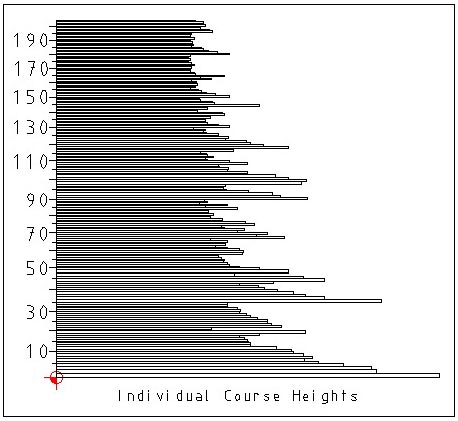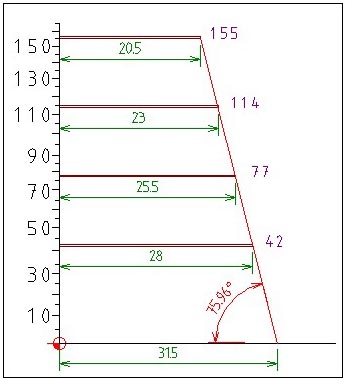ANDREW
CONNER'S RESEARCH
Analysis and Method for the Giza Great Pyramid
Masonry Courses Part 1.
Introduction:
The Great Pyramid has probably been the most earnestly measured architectural structure ever to exist. As the last remaining wonder of the ancient world, it is remarkably un-interesting with regard to the recovery of tangible artefacts yet as a monument of megalithic proportions has sustained the interest of expert and amateur alike with a mystical alure to explain it's reason for existence and method of construction.
Notwithstanding the internal passages and chambers, the limestone masonry courses as defining the external structure itself are and have been for generations the subject of measurement and continuous speculation. Individual courses were measured and the the results published by Piazzi Smyth¹ and subsequently by W. Flinders Petrie² both over a century ago.
Smyth measured course heights and corresponding elevations above base to the nearest British inch which were published in tabular form. Petrie measured and recorded heights and elevations at geographic corners with decimal accuracy and presented the data in a graphical format utilising cumulative individual course heights. See here for a standard reference to Petrie's data.
Course Information:
A general summary of course particulars is given in the following table:-
|
Statistics of G.P. Masonry Courses |
|||
|
Number of Courses |
Maximum Course Height |
Minimum Course Height |
Mean Course Height |
|
203 |
58.6 |
19.7 |
26.851 |
|
Range |
Median |
Std.Deviation |
Variance |
|
38.9 |
25.3 |
6.401 |
40.973 |
The course data can be represented as follows with cumulative heights against individual course heights. The vertical axis which represents elevation above base has been scaled at 100:1 and the axis labeled with the course numbers.

It was noted by Petrie that thicker courses are located at certain levels above the pavement baseline and that the average course heights decreased with elevation. These observations have not been significantly expanded upon since.
Mr Yashika Sue³ has more recently verified these general trends but has been unable to establish any mathematical patten.
The course data envolope does however exhibit a somewhat serrated profile with a fractal-like apearance. This would suggest that there could in fact be an underlying algorithm within what outwardly appears to be a somewhat random choice of course heights.
As an engineering project of such magnitude, it seems ludicrous that a standard dimension had not been chosen for masonary course heights. Multiples and fractions of which could be utilised within the scope of construction practices.
The purpose of this article is to show that the ancient Egyptian architect/s had in fact an organised and pre-conceived scheme which dictated the thickness of masonry courses at specified elevations.
Method Defined:
Groups of masonry courses have been identified as belonging to specific sets. The example given below for set #4 exhibits a very accurate representation of the scheme.
For the purpose of this method it should be noted that the elevation for a specific course number should be taken for that of the course directly below when reading from Petries's data. Petrie used the top of each course as a datum although it is valid that any given physical course, has both a top and bottom elevation.
|
Key Courses - Data Sheet Set #4 |
|
 |
Course No.s
155 114 77 42 |
|
Notes: 1. The sum of Course No.s = 55x7 +3 2. The defining angle is exactly arctan (4) 3. The common interval between courses is 1000. The initial course is
1400 above base. |
|
Other Courses:
The following are given as additional examples however it should be stated that they are not intended to be interpreted as being complete.
|
Key Course Sets |
|||
|
Set ID |
Course Numbers |
Defining angle |
Base Offset |
|
#1 |
192 185 145 |
68.15º |
40.92 |
|
#2 |
152 126 114 96 |
90.00º |
23.00 |
|
#3 |
197 144 118 1 |
56.46º |
58.60 |
|
#4 |
155 114 77 42 |
75.96º |
31.50 |
|
#5 |
191 121 36 |
63.45º |
47.03 |
|
#6 |
197 118 |
56.10º |
59.08 |
|
#7 |
169 142 |
67.56º |
40.00 |
|
#8 |
122 97 63 |
90.00º |
26.00 |
|
#9 |
141 135 |
81.88º |
26.81 |
|
#10 |
150 48 5 |
71.57º |
40.87 |
|
#11 |
158 19 |
66.51º |
41.00 |
|
#12 |
50 42 31 17 |
90.00º |
28.00 |
Attributes 1:
|
Sums of Course Numbers |
|||
|
Set ID |
Sum of Course Numbers |
Nearest Multiple of 7 |
Error +/- |
|
#1 |
522 |
75 |
-3 |
|
#2 |
488 |
70 |
-2 |
|
#3 |
460 |
66 |
-2 |
|
#4 |
388 |
55 |
+3 |
|
#5 |
348 |
50 |
-2 |
|
#6 |
315 |
45 |
0 |
|
#7 |
311 |
44 |
+3 |
|
#8 |
282 |
40 |
+2 |
|
#9 |
276 |
39 |
+3 |
|
#10 |
203 |
29 |
0 |
|
#11 |
177 |
25 |
+2 |
|
#12 |
140 |
20 |
0 |
Attributes 2:
|
Defining Angles |
|||
|
Set ID |
Defining angle |
arctan of Defining Angle |
|
|
#1 |
68.15º |
2.49 |
|
|
#2 |
90º |
inf. |
|
|
#3 |
56.46º |
1.51 |
|
|
#4 |
75.96º |
4.00 |
|
|
#5 |
63.45º |
2.00 |
|
|
#6 |
56.10º |
1.49 |
|
|
#7 |
67.56º |
2.42 |
|
|
#8 |
90º |
inf. |
|
|
#9 |
81.88º |
7.00 |
|
|
#10 |
71.57º |
3.00 |
|
|
#11 |
66.51º |
2.30 |
|
|
#12 |
90º |
inf. |
|
In Conclusion: 1. This article outlines the architect/s method which explains the
profile of the masonry course diagram presented herein. References: 1. Piazzi Smyth - The Great Pyramid Copyright © MMII Reproduction prohibited
without written consent of the author. Eur.Ing. A.D.Conner B.Sc.
C.Eng. M.R.I.N.A.
2. The implicit use of the numbers 5,7 and 11 should be noted.
3. Where tangent angles have been mentioned, these can be substituded
with simple gradients.
4. The relationship between base offsets and key course intervals have
not been included in this presentation.
5. By utilising different scaling factors similar relationships have been
found to exist.
2. W.M.Flinders Petrie - The Pyramids and Temples of Gizeh
3. Yoshiki Sue - http://www.mars.sphere.ne.jp/p-inpaku/Pyramid/Courses.htm